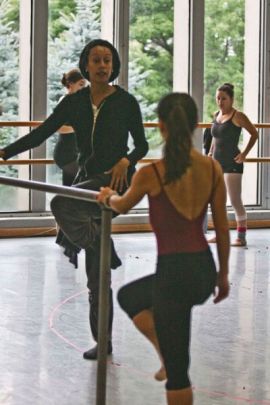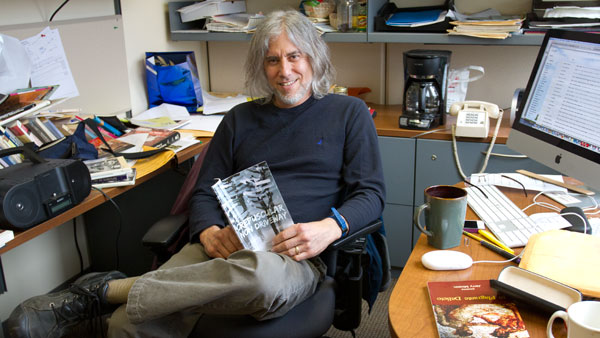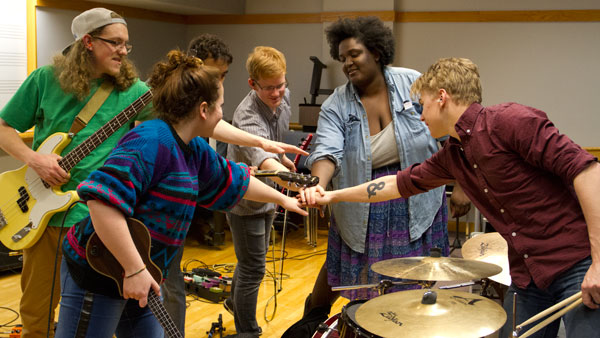In Dillingham Center’s Studio 3, austere ballerinas stand in first position with their hair slicked back into tight buns. Suddenly, they fall to the floor, curl their spines upward and lift their bodies into a kneel, facing away from the barre. With arms extended, they push against the wall with controlled force into a standing position.

Stefanie Batten Bland teaches this and other untraditional ballet moves in her innovative Ballet III class at Ithaca College. As a choreographer with a background in contemporary, jazz, ballet and musical theater, she has worked with established choreographers around the world. Presently, she is filling in for the college’s ballet instructor for the theater arts program, Amy O’Brien, who is on an eight-week maternity leave.
Bland and O’Brien met their freshman year at the State University of New York at Purchase’s dance conservatory.
O’Brien said Bland was the first person to pop into her head when she realized she needed someone to substitute teach her classes.
“She’s the type of person that will take the challenge of doing many things,” O’Brien said. “She has this incredible energy.”
Teaching ballet classes at the college is a new experience for Bland, who is mainly versed in contemporary dance, and her students are also adjusting to a new professor.
Sophomore ballet student Laura Kathrein said she finds Bland’s class at the college to be fulfilling.
“I think she’s just challenging our level in a completely different way,” Kathrein said. “Stefanie’s definitely breaking us out of our comfort zone.”
Bland grew up in Soho, a Manhattan neighborhood, with her mother, a white French-speaking writer, and her father, a black composer of jazz and classical music. She said she felt pressured into dancing for companies like Alvin Ailey that emphasize African-American heritage but was turned off by the idea.
“Everyone told me since I was black — or half-black, or a little bit different from white — that I needed to go to [Alvin] Ailey,” she said. “I knew I didn’t want to do that. I wanted to explore what this body could do, and I didn’t want to be put in a box.”
She left SUNY-Purchase after her sophomore year to pursue a career in dance. At first, she waited tables and did some background commercial acting while dancing for different choreographers.
“I did anything I could get my hands on,” she said.
She danced for renowned American choreographer Bill T. Jones until German choreographer Pina Bausch hired her — prompting her move to Germany.
She left Germany, moved to Switzerland and then moved to Paris where she lived and danced for six years. She also met her husband, cinematographer Guillaume Le Grontec there. The two combined their artistic skills and created dance films shown around the world.
Bland said the European dance world gives more flexibility to dancers of all ages and backgrounds.
“You’re allowed to become a woman dancer; you’re allowed to become a mother dancer; you’re allowed to become an older dancer,” she said. “You’re allowed to age.”
Last year, she founded her own dance company in France, “Company Stefanie Batten Bland.” She calls her group a “flock of funky people.” With a mixture of Americans and Parisians, the group represents a diverse body of dancers.
She said the Americans provide speed to routines, while Europeans add rich detail.
“The Americans pep up the French; the French ground the Americans,” she said. “We’re just a goofy group.”
The company is performing at 7 p.m. Saturday in Dillingham’s Hoerner Theatre. The group will perform a piece titled “Chapters,” consisting of three ballets and three dance films, all of which can be viewed on Bland’s Web site, www.Birdlegs.net. Bland’s choreography uses her father’s musical compositions.
Of all the performers in the group, Parisian dancer Raphaël Kaney Duverger has worked with Bland the longest. He said learning from her for four years has been a motivating journey.
“She lets you express yourself even if the choreography is very precise,” he said. “She’s really open to other movement.”
Bland hopes she can inspire the students to find their own sense of individuality.
“I hope that I am giving them the tools necessary so that they can continue and become the most effective, creative people possible,” she said. “I try to give them the gift of not being afraid to take risks.”




